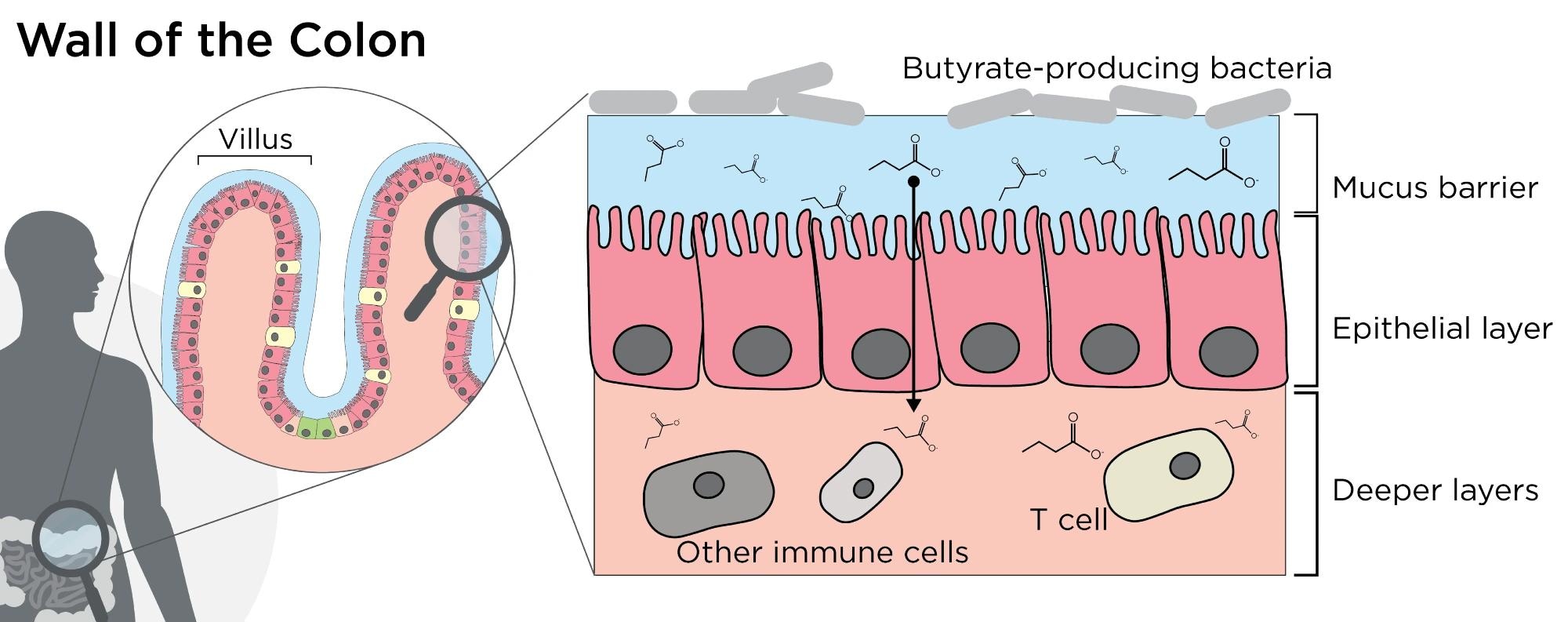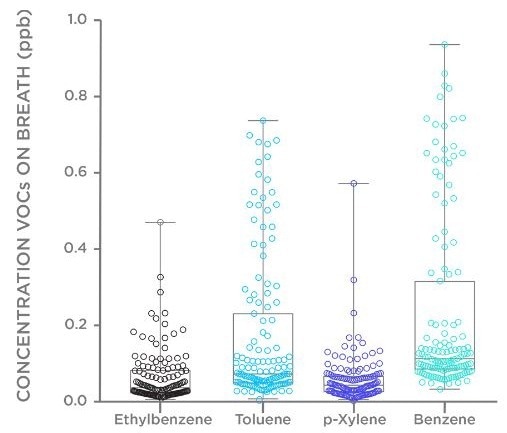This article will cover where volatile compounds in the breath originate from, endogenous compounds, and exogenous compounds.
Where do volatile compounds in the breath originate from?
Breath comprises many compounds of interest that can be leveraged as biomarkers for clinical research and applications. It is enriched with volatile organic compounds (VOCs) that can act as biomarkers for various possible clinical applications, including as diagnostic tests and monitoring metrics during clinical trials.
A profound number of compounds are created within the body on a constant basis, through various ongoing metabolic processes, but from what processes do the volatile chemicals found in breath originate?
There are two primary origins of volatile compounds: those that are created inside the body, known as endogenous compounds, and those created outside of the body, known as exogenous compounds.
Endogenous compounds
Two examples of endogenous processes in the body that result in the creation of volatile compounds are: inflammation, and the Warburg effect, a form of altered metabolic state commonly seen in cancerous cells..
Inflammation is associated with the pathology of numerous diseases and conditions. Long-term chronic inflammation can be detrimental to health and is increasingly prevalent with age.
Inflammation is a complex and multifaceted process that can cause oxidative stress within cells, resulting in lipid peroxidation.
Lipid peroxidation produces volatile compounds like acetaldehyde, alkanes, alkenes, and other small-chain hydrocarbons. Crucially, the specific lipid composition of cells can vary across different cell types and bodily tissues affected, and therefore the composition of volatile lipid peroxidation products may be able to distinguish different disease pathologies. From here, the pattern of volatile lipid peroxidation products in breath acts as potential biomarkers for the presence of related diseases.
The Warburg effect denotes an altered form of metabolism and sees the transfer from the dominant form of energy production, the Krebs cycle, to glycolysis. The body then produces a considerably different molecular signature, which includes increased ketones like acetone, acetoacetate, and β-hydroxybutyrate produced from an excess of acetyl-COA.1
This leads to increased levels of compounds such as acetone in the body, a volatile chemical that can easily pass through the blood and be detected in exhaled breath.
How volatile chemicals are arranged in terms of pattern or signature in exhaled breath may signify altered biological processes in the body, presenting a solid argument for their application as biomarkers in medical technology.
Exogenous compounds
While many volatile compoudns originate from metabolic processeswithin the body, a significant number of volatile chemicals can originate externally, including fromair inhaled from current and recent environmental exposure, the diet, or from microbial metabolism in the body.
Two examples of exogenously originating VOCs will be outlined here: butyrate, which originates from gut microbial metabolism, and BTEX compounds (benzene, toluene, ethylbenzene, and xylenes), which are environmental compounds.
Butyrate is a short-chain fatty acid produced through a process of the microbial fermentation of dietary fiber in the colon. Butyrate is specifically produced through the butyryl CoA-Acetate CoA transferase pathway and the specific microbial species in the gut; moreover, the amount and type of fiber consumed in the diet can influence the overall amount of butyrate produced.2
Butyrate has a physiological impact on the body, such as regulating the immune system and directly impacting metabolic processes such as lipid and glucose metabolism through direct interaction with receptors.
Butyrate is volatile and microbially produced, but it is detectable in exhaled breath. Although butyrate is produced by microbes situated physically within the body, it is still considered exogenous as it arises from non-human metabolism. The method of butyrate entering the breath is analogous to endogenously originating volatile compounds. The volatile compounds generated in the gastrointestinal tract can pass through the surrounding blood vessels and find their way into the air in the lungs at the alveolar surface.

Image Credit: Owlstone Medical Ltd
The exogenous VOCs that have been inhaled from the outside air can be considered in two ways: first, as background signals that can be discarded for analytical purposes,or as informative compounds to help evaluate environmental exposure to certain chemicals.
The World Health Organization estimates that a considerable number of deaths worldwide are associated with environmental risk factors from an unhealthy living or working environment. Exposure to air, water, and soil, which contains noxious compounds and other chemical pollutants, can result in diminished general health, increasing the risk of certain diseases and injuries.3
Prolonged exposure to BTEX compounds can impact the body’s organs, making them a common chemical of interest in exposure studies. Increased levels of benzene, in particular, are known causes of certain types of cancer, such as leukemia.
Typical sources of BTEX exposure are smoking, vehicle emissions, solid fuel fires, and occupational exposure. Due to the widespread exposure and associated health effects, they are helpful target compounds when measuring exposure rates in exhaled breath.

Image Credit: Owlstone Medical Ltd
Owlstone Medical analyzed how levels of BTEX compounds in exhaled breath could be measured down to PPT concentrations. In this study, researchers could distinguish between smokers and non-smokers based on the concentration of benzene and other markers in breath. Further information on this study is available here.
References and further reading
- Janfaza S, Khorsand B, Nikkhah M, Zahiri J. Digging deeper into volatile organic compounds associated with cancer. Biol Methods Protoc. 2019 Nov 27;4(1):bpz014. DOI: 10.1093/biomethods/bpz014
- Cronin P, Joyce SA, O’Toole PW, O’Connor EM. Dietary Fibre Modulates the Gut Microbiota. Nutrients. 2021 May 13;13(5):1655. DOI: 10.1093/biomethods/bpz014
- An estimated 12.6 million deaths each year are attributable to unhealthy environments [Internet]. [cited 2023 Jun 13]. Available from: https://www.who.int/news-room/facts-in-pictures/detail/preventing-disease-through-healthy-environments
About Owlstone Medical Ltd
Owlstone Medical is developing a breathalyzer with a focus on non-invasive diagnostics for cancer, inflammatory disease and infectious disease, the company aims to save 100,000 lives and $1.5B in healthcare costs.
The company’s Breath Biopsy® platform has introduced a new diagnostic modality making it possible to discover novel non-invasive biomarkers in breath using a platform with the potential to transition to point-of-care. The award winning ReCIVA Breath Sampler ensures reliable collection of breath samples.
Breath Biopsy is supporting research into early detection and precision medicine with applications in cancer and a wide range of other medical conditions. Highly sensitive and selective, these tests allow for early diagnosis when treatments are more effective and more lives can be saved.
Sponsored Content Policy: News-Medical.net publishes articles and related content that may be derived from sources where we have existing commercial relationships, provided such content adds value to the core editorial ethos of News-Medical.Net which is to educate and inform site visitors interested in medical research, science, medical devices and treatments.